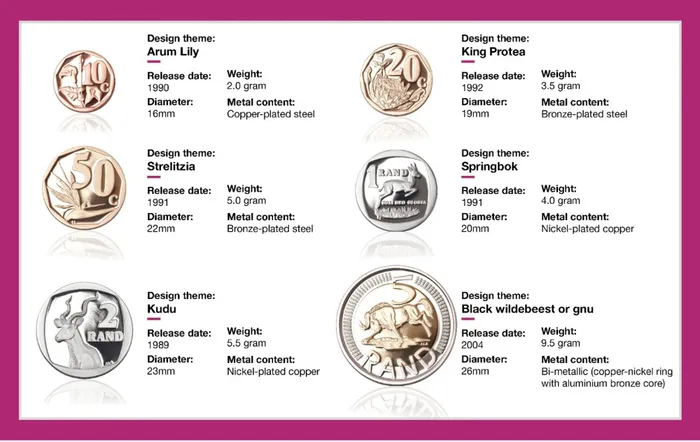South Africa is getting new coins - here’s what you can expect

The Cabinet has approved the fourth decimal coin series of South Africa which will see coins being transformed next year. Picture: Reserve Bank
Pretoria – Coins are set for a major makeover next year after the Cabinet approved amendments to the fourth decimal coin series of South Africa this week.
“The Cabinet has approved the dimension, design and compilation of the 2023 fourth decimal coin series of South Africa. It approved the annual rotational system of the usage of the official languages on the fourth decimal coin series,” the Government Communication and Information System (GCIS) said.
The word “South Africa” will be inserted on one side of the coins and printed in all the official languages.
“Three languages will be used in the R5 coin; two languages on R2; 50c, 20c and 10c coins and the R1 coin will be in one language. All these languages will be used on an annual rotational basis over the next 10 years,” the GCIS added.
South Africa is currently using the third decimal coin series, which was introduced in 1989.
According to the South African Reserve Bank (SARB) website, South African currency has evolved from the early days when bartering was the prevalent form of trading. Commercial banks kept and secured people’s items of value and in return issued them with promissory notes.
This trusted system evolved to banknotes and coins.
South Africa has a rich history of currency usage, formalised with the introduction of coin in the region in 1652. Since then, the SARB says the country has used different currencies and coins which were made from copper, silver and gold.
From 1956 to 1958, the Decimalisation Coin Commission explored the decimalisation of South African currency, with their recommendations adopted in the Decimalisation Coin Act of 1959.
“In 1961, when the Republic of South Africa was proclaimed, the country formally adopted a decimal system, with coins being converted to their decimal equivalent resulting in the one pound becoming a two-rand coin, the one shilling a ten-cent coin and the three pence a two-and-a-half cent coin. This system remained in place until 1964,” the SARB said.
Currently, South Africa has six coin denominations in circulation, namely, the 10c, 20c, 50c, R1, R2 and the R5.
The 10c is the smallest at 16mm and the R5 is the largest at 26mm. According to the SARB, an important consideration in having the different sizes and rim finishes was that visually impaired people could identify the particular denomination with their fingers when transacting.
Circulation coins are made of metal or alloy. These coins are used in everyday transactions, circulating alongside banknotes.
Various ridges, rims, serrations and different metals on the coins are incorporated as part of the security features.
Machines such as vending machines are programmed with software and sensors to recognise these circulation coins and to accept them accordingly.
Electroplated coins were introduced in 1989 as a solution to the escalating costs of materials and manufacturing and the increasing risk of falsification.
A bi-metal R5 coin was launched in 2004 to replace the R5 nickel coin.
IOL